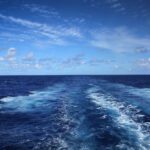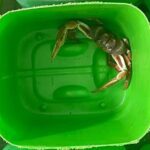In Canada, plastic pollution of our waterbodies is an emerging concern in a crowd of aquatic stressors. Similar to chemical contaminants such as PCBs, plastics can be pervasive across both time and aquatic food webs. In the oceans, reports of ingested plastic by seabirds have spanned a half century: surveys from 1966–1967 found “plastic toys” in the stomachs of Herring Gull in Newfoundland, and today macroplastics (plastics > 5 mm) and microplastics (plastics < 5 mm) are found in the stomachs of northern fulmar in Nova Scotia. The fishes these seabirds rely on as a food source themselves contain plastics: sand lance from Vancouver Island’s shores had black, red, and blue microplastic filaments in their stomachs. And in turn, even the zooplankton these fishes eat may also contain plastics: species of zooplankton from the North Pacific ingested microplastics in a laboratory experiment. Plastics are now ubiquitous in Canadian waters and sediments.
Is the same plastic takeover happening in Canada’s fresh water? Last summer, scientific voyagers eXXpedition organized sampling voyages throughout the Laurentian Great Lakes. More recently, a FACETS study found microplastics in the Ottawa River; microfibers (shed from synthetic clothing or rope) were the predominant type of microplastic found.
The efforts to locate and quantify the degree of plastic pollution in Canadian fresh waters are necessary—the data collected allow us to understand our environmental reality and provide the evidence needed to develop sound environmental policy. The efforts are also tremendously intensive.
Plastic fibers in fish guts
Samantha Campbell was an undergraduate student at the University of Regina when she was tasked with combing through the stomachs of 181 fish collected from Wascana Creek, a channel of water that winds for 50 km through farmlands west and north of the city of Regina. Campbell and her supervisor, Dr. Britt Hall, were looking for microplastics. They found them and recently published their findings in FACETS.
The methods for counting plastics from start to finish are quite incredible when considered in detail. First, Campbell and her colleagues waded through the ~5 m wide sludgy creek and seined for fish while engulfed by an odour of sulphur. The fish were then brought back to the laboratory and each fish’s stomach was carefully dissected out, rinsed with ethanol, chopped up finely, and dissolved using enzymes that degrade organic tissue (each enzymatic digestion process takes 30 minutes). The resulting solution was filtered through a series of different sized meshes and the mesh screens were rinsed with water and placed in glass petri dishes that were then dried in an oven. Only after this entire process was repeated for all 181 fish did the hunt for plastics begin. Each petri dish found its place under a microscope, and Campbell counted individual pieces of plastics, confirming they were indeed plastic by pressing a heated needle tip to the particle to confirm it melted. Logging over 500 hours in the lab (equivalent to watching the entire series of The Office seven times), Campbell found microplastic fibers, fragments, and beads from the processed stomachs of northern pike, white sucker, emerald shiner, fat head minnow, and five-spine stickleback. She also found microplastics in water samples from Wascana Creek.

Microplastic fiber
Another unexpected finding was the presence of clear plastic microfibers inside and outside their petri dishes, even when the dishes did not have any samples in them (but did have digestion reagents and rinsing fluids). When Campbell worked inside a pressure hood that restricted unfiltered laboratory air, the number of clear fibers was reduced. Are plastic microfibers floating in the air? The source of these clear fibers remains speculative without further study. Clear plastic microfibers were also found in the fish and water samples collected from Wascana Creek and were indistinguishable from those found in the laboratory. (The counts of clear fibers were removed from the study’s statistical analyses.)The amount of plastic found in Wascana Creek was surprising to Campbell and Hall. The concentrations of microplastics in their study were similar to those in the Laurentian Great Lakes, which receive effluent from numerous metropolises (Regina’s population as of 2015 is ~240,000). Effluent from Regina’s waste water treatment plant does flow into Wascana Creek but Campbell and Hall predicted the facility’s settling ponds would catch the majority of plastics before the water flowed into the creek.
Next steps to tackle the unknowns
Regina’s waste water treatment plant has since been converted to a bioreactive treatment system; effluent no longer passes through the settling ponds prior to entering Wascana Creek. Has this conversion to increase efficiency resulted in more microplastics entering Wascana Creek? Campbell and Hall say that their study needs to be repeated to determine if this is the case.
The time and resources required to replicate the study would be substantial, but Campbell notes that the long hours were “well worth it to figure out the result that there are plastics in this small creek that no one would really think about [being polluted].”
The hours, days, months, and years required to collect microplastics data can lead to change. Microbeads are to be banned next year in Canada. Mountain Equipment Co-op has started a dialogue with their clothing manufacturers to address plastic microfibers.
As Canada’s aquatic landscapes continue to be challenged by the pressures we put them under, meticulously gathered data on microplastics will help us understand their effects on the environment and will be the foundation that drives innovation and adoption of new technologies and policies to mitigate pollution.




